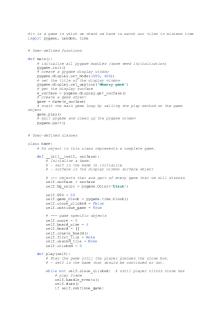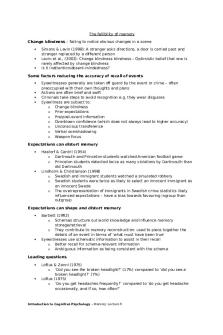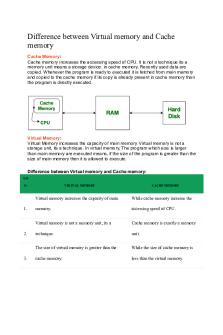Memory PDF

| Title | Memory |
|---|---|
| Course | CULTURAL PSYCHOLOGY |
| Institution | York University |
| Pages | 3 |
| File Size | 133.2 KB |
| File Type | |
| Total Downloads | 39 |
| Total Views | 174 |
Summary
lecture notes on memory...
Description
CHAPTER 25 – MEMORY
Studying Memory -
Memory: the persistence of learning overtime through the encoding, storage, and retrieval of information
Measuring Retention -
It was a psychologist, evidence that learning persists includes these three measures of retention: o Recall retrieving information that is not currently in your conscious awareness but that was learn at an earlier time (i.e. fill in the blank question) o Recognition identify items previously learned (i.e. multiple-choice question) o Relearning Learning something more quickly when you learn a second or later time (i.e. study for a cumulative final exam) ** these indicate memory strength
Memory Models -
-
-
-
-
To remember any event, we must: o Get that information into our brain (encoding) o Retain the information (storage) o Later get the information back out (retrieval) Parallel Processing: the brains natural mode of information by processing many aspects of a problem simultaneously o Connectionism views memories as products of interconnected neural networks Every time you learn something new year brings neural connections change (new pathways) Richard Atkinson and Richard Shiffrin proposed a three-stage model: 1. We first record to be remembered information as fleeting sensory memory 2. From there, we process information into short term memory, where we encode it through a rehearsal 3. Finally, information moves into long-term memory for later retrieval
Working Memory: a newer understanding of short-term memory that adds conscious, active processing of incoming auditory and visual information, and information retrieved from long-term memory o Ex: right now, you are using your working memory to link the information you are reading with your previously stored information Allan Baddeley’s model a “central executive” handles focus processing
RP-How does the working memory concept update the classic Atkinson-Shiffrin three stage information processing model? The new her idea of a working memory emphasizes the active processing that we now know takes place in Atkinson Shiffrin short-term memory stage. While the Atkinson Shiffrin model viewed short-term memory as a temporary holding space, working memory plays a key role in processing new information and connecting it to previously stored information. RP-what are the two basic functions of working memory? 1. Active processing of incoming visual and auditory information, and 2. Focusing our spotlight of attention
Encoding Memories -
-
Explicit Memory: retention of facts and experiences that one can consciously know and declare o Atkinson and Shifrin’s model o Declarative memories Effortful Processing: encoding that requires attention and conscious effort o We encode explicit memories Automatic Processing: unconscious encoding of incidental information (such as space, time, and frequency) and of well learned information (such as word meanings) Implicit Memory: retention of learned skills or classically conditioned associations independent of conscious recollection o Nondeclarative memories
Automatic Processing and Implicit Memories -
-
Our implicit memories include procedural memory for automatic skills (riding a bike) and classically conditioned associations among stimuli o If attacked by a dog in childhood, years later you may, without recalling the conditioned association, automatically tense up as a dog approaches Without conscious effort you also automatically process information about: o Space visualizing a location o Time unintentionally noting the sequence of events (remembering what time of the day you lost your watch; retracing steps) o Frequency how many times things happen
Effortful Processing and Explicit Memories -
-
Effortful processing must occur before automatic processing o i.e. learn to understanding the language: at first it is difficult but after a while it becomes automatic Sensory Memory o Iconic Memory: a momentary sensory memory of visual stimuli (a photographic or picture image memory lasting no more than a few tenths of a second) o Echoic Memory: a momentary sensory memory of auditory stimuli (if attention is elsewhere, sounds and words can still be recalled within three or four seconds) Short-term Memory Capacity o What we can briefly retain o George Miller propose we can store about seven pieces of information in short-term memory o Working memory capacity – ability to juggle multiple items while processing information Reflects intelligence level
RP-What is the difference between automatic and effortful processing? Automatic processing occurs unconsciously (automatically) for such things as the sequence and frequency of the days events, in reading and comprehending words in our own language(s). Effortful processing requires attention and awareness and happens when we work hard to learn new material in class or lines for a play.
Effortful Processing Strategies -
-
Several effortful processing charges can boost our ability to form new memories – later when we try to retrieve the memory of these strategies can make the difference between success and failure Chunking: organizing items into familiar, manageable units; often occurs automatically o Enables us to recall it more easily o Ex: remembering a set of letters M G V S R M T as MGV SRM T Mnemonics: memory aids, especially those techniques that use vivid imagery and organizational devices o Ex: HOMES for remembering Ontario’s Great Lakes (Huron, Ontario etc.) Hierarchies: placing broad concepts into narrower concepts and facts (subdivisions)
Distributed Practice -
We retain information better when our encoding is distributed overtime – Long term recall Spacing Effect: the tendency for distributed study or practice to yield better long-term retention than is achieved through massed study or practice o Testing Effect: enhance memory after retrieving, rather than simply rereading, information Repeated self testing Protects our memory from harmful effects of stress
Levels of Processing -
-
Memory researchers have discovered that we processed verbal information on different levels and the depth of processing affects our long-term retention Shallow Processing: encoding on a basic level, based on the structure or appearance of words o Elementary level (word’s, letters); intermediate level (a word’s sound) o Thus mistaking their, there, and they’re Deep Processing: encoding semantically, based on the meaning of the words; tends to yield the best retention o Deeper (more meaningful) the processing, the better the retention The amount remember depends both on the time spent learning and on your making it meaningful for deep processing...
Similar Free PDFs

Memory
- 3 Pages

Memory
- 5 Pages

Virtual Memory
- 58 Pages

CACHE MEMORY
- 1 Pages

Memory Psych
- 1 Pages

Virtual Memory
- 17 Pages

Memory notespack
- 16 Pages

Memory Management
- 5 Pages

9.) Memory
- 4 Pages

Nondeclarative Memory
- 3 Pages

Memory Internal
- 34 Pages
Popular Institutions
- Tinajero National High School - Annex
- Politeknik Caltex Riau
- Yokohama City University
- SGT University
- University of Al-Qadisiyah
- Divine Word College of Vigan
- Techniek College Rotterdam
- Universidade de Santiago
- Universiti Teknologi MARA Cawangan Johor Kampus Pasir Gudang
- Poltekkes Kemenkes Yogyakarta
- Baguio City National High School
- Colegio san marcos
- preparatoria uno
- Centro de Bachillerato Tecnológico Industrial y de Servicios No. 107
- Dalian Maritime University
- Quang Trung Secondary School
- Colegio Tecnológico en Informática
- Corporación Regional de Educación Superior
- Grupo CEDVA
- Dar Al Uloom University
- Centro de Estudios Preuniversitarios de la Universidad Nacional de Ingeniería
- 上智大学
- Aakash International School, Nuna Majara
- San Felipe Neri Catholic School
- Kang Chiao International School - New Taipei City
- Misamis Occidental National High School
- Institución Educativa Escuela Normal Juan Ladrilleros
- Kolehiyo ng Pantukan
- Batanes State College
- Instituto Continental
- Sekolah Menengah Kejuruan Kesehatan Kaltara (Tarakan)
- Colegio de La Inmaculada Concepcion - Cebu




